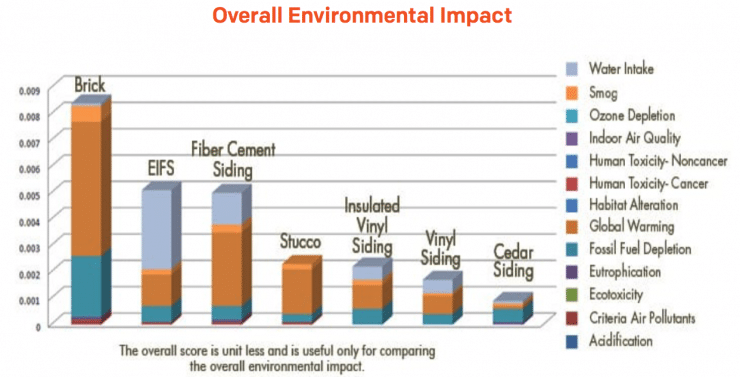Problems with Vinyl Siding: Solved

In the past, some vinyl siding experienced problems like fading, sagging, and cracking. Manufacturing and installation of vinyl siding has come a long way in recent years, and most of these problems are a thing of the past.
This article will discuss the five 5 most common misconceptions with vinyl siding and the truth behind them, including:
- Vinyl warps and buckles
- Vinyl is susceptible to damage
- Vinyl provides no r-value
- Vinyl is for the environment
- Vinyl lowers property value
#1: Vinyl Siding Warps and Buckles
Warping and buckling are both problems associated with vinyl siding, these issues only occur when the siding is not installed correctly.
Vinyl siding expands and contracts as the outside temperature changes. In the summer, when temperatures are high, vinyl expands. In the winter, when temperatures are low, vinyl contracts. To avoid this problem, vinyl siding must be installed in a way that allows it to move.
Insulated vinyl siding can also help with warping and buckling. The supportive foam helps maintain sharp, crisp profile lines that best simulate the appearance of real wood.
Homes settle and walls shift over time, creating imperfections that can be seen through thin siding products. By adding a cushioning layer of insulation, insulated vinyl siding can help eliminate the appearance of imperfect walls.
#2: Vinyl Siding is Not Durable
Vinyl siding is made from a tough plastic material called polyvinyl chloride (PVC). Vinyl siding is designed to withstand winds up to 100mph and is moisture resistant, so it will not corrode or rot over time. Unlike other cladding, vinyl never needs to be painted, manufacturers use advanced UV resistant coatings to ensure the color remains.
Insulated vinyl siding increases the durability of standard vinyl siding. Insulated vinyl fills the hollow void behind the siding with a foam backer and acts as a shock absorber against impact.
Insulated siding accessories, such as corner posts and starter strips, also help protect the siding at its most vulnerable points, the corners and the base of the wall.
#3: Vinyl Siding Has a Low R-Value
With heating and cooling costs on the rise, consumers are searching for products that provide energy savings. The average r-value of a vinyl siding panel is about .61, this is compared to fiber cement at .37 and brick at .44. To increase r-value, many homeowners chose to add insulation to the wall before installing vinyl siding. This increases the r-value of the wall system and provides energy savings.
Insulated vinyl siding products come with contoured insulation that is permanently adhered to the siding during manufacturing. This provides a wide range of benefits related to appearance, durability, and energy savings. To see potential utility bill savings with insulated siding, check out our article Insulated Vinyl Siding Cost: A Guide to Pricing, Estimates, and ROI.
#4: Vinyl Siding is Bad for the Environment
Sustainability is becoming increasingly important to homeowners, builders, and manufacturers; we want to make sure the materials we are using are what’s best for the environment.
Some believe that vinyl siding is bad for the environment, and is manufactured using harsh chemicals and gases. According to the Building for Environmental and Economic Sustainability (BEES), software developed by the National Institute of Standards and Technology (NIST), vinyl siding performs better than fiber cement and brick in economical and environmental performance (see the graph below).
Vinyl Siding Institute
According to the Vinyl Siding Institute, vinyl siding is made with natural ingredients including 57% chlorine from common salt and 43% ethylene from natural gas. The manufacturing process of vinyl siding is also highly efficient, any scrap that is produced can be placed back into production.
One thing the study above does not discuss is energy savings. Insulated vinyl siding will reduce energy and carbon usage every day it is on the house, saving money and having a better impact on the environment. The chart below compares the overall environmental impact of various cladding products.
#5: Vinyl Siding Lowers Property Value
Does vinyl siding lower property value? The short answer is no. According to Remodeling Magazine’s 2018 Cost vs. Value Report, 76.4% of siding replacement costs are recouped, which is significantly higher than a major kitchen remodel at 65.3%, roof replacement at 68.8%, and even a window replacement at 73.9%. As an example, if you spend $20,000 on a siding replacement, you can expect to recoup $15,280, leaving the true cost of your siding around $4,720.
When considering resale or property value it is important to make sure the siding you select will maintain its appearance over time. If you select the cheapest vinyl siding that may crack, dent, or fade over time, it’s likely you won’t recoup the full 76.4% anticipated by Remodeling Magazine. To learn more about this topic, read our article: Will Vinyl Siding Increase My Home’s Value?
Summary
There are many common misconceptions about vinyl siding in the marketplace. Vinyl siding is a maintenance free product that can increase the curb appeal of your home. Common problems with vinyl siding can be solved by adding a foam backer or using an insulated vinyl siding panel. For more information on insulated vinyl siding check out our article: What is Insulated Vinyl Siding? Materials, Pros, Cons and Installation.




